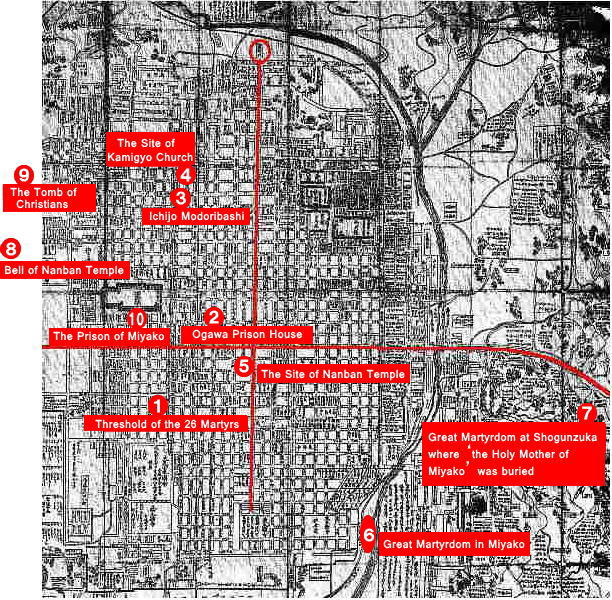Map showing places in Kyoto where Christians were martyred

-
① Threshold of the 26 Martyrs
In 1593, Father Pedro Bautista and three other Friar Minors were dispatched to Japan.
Although an edict to ban Christianity was imposed in Japan at the time,
the friars were given a vast extent of land at the site of Myoman Temple in Kyoto from Hideyoshi Toyotomi.
They established a church, a monastery and two hospitals at the site and began their missionary work.
More than 200 Christians moved into the area and people in Kyoto called the place “Daiusu cho” while Christians called it “Shotenshi no gengo no machi (city of angels: Los Angels.)”
However, in 1596, Hideyoshi issued an edict to arrest Christians in Osaka.
Observing the edict, Leo Karasuma and 4 other believers were taken up on December 9, 1596, followed by the capture of Father Bautista and 11 believers early in the morning of January 2, 1597.
Journey to the martyrdom on the hill of Nishizaka, Nagasaki began on this day.
Now a hospital stands on the place that is considered to be the site of the hospital back then,
as if to tell us that God’s plan remains unchanged despite the time lapse. -
② Ogawa Prison House
The 26 Martyrs were arrested and imprisoned here.
In 1619, the year of “Great Martyrdom in Miyako (Kyoto)”,
a total of 63 believers were imprisoned and eight of them including 2-year-old toddlers who were born in Kyoto, Miguel and Pedro, became martyrs in this prison. -
③ Ichijo Modoribashi
On January 3, 1597, among the 26 Martyrs, 24 believers including Father Bautista had their ears cut off.
Then they were divided into groups of three and put on 8 cow carriages to be dragged about within the city.
It is said that when his ear was cut, Tome Kosaki told the government officials,
“If you wish, please cut my ear more and shed the blood of Christians until you are satisfied.”
(On January 3, 2001, our church members spent more than three hours walking with prayer, following the paths that the 26 Martyrs were dragged about. 2001 became the year of blessing to our church.) -
④ The Site of Kamigyo Church
Locating near Ichijo Modoribashi, the church of Jesuit was built in 1600.
In those days, this area was a residential district of court nobles and samurai class people.
It is said that over 100 people were baptized every year at this church until it was closed down by Tokugawa shogunate in 1612. -
⑤The Site of Nanban Temple
With cooperation of Ukon Takayama and other believers, Jesuit Priest Organtino began the construction of new church in 1575 and on August 15, 1576, the first mass was offered at the church. The church of 3 stories was called, “Nanban Temple” and became a famous place in Miyako (Kyoto). However, the church was torn down due to Hideyoshi’s deportation edict of Christian missionaries, issued in 1587.
-
⑥ Great Martyrdom in Miyako
In 1619, a massive suppression against Christian took place in Miyako (Kyoto). On January 10th, 36 Christians were captured and additional believers were captured in April and July. On October 6th, 52 Christians died martyrs at Rokujo-Kawaramachi where they were tied on 27 crosses and set on fire. None of them were priests nor monks but ordinary believers, their wives and children including 2-3 years old toddlers and an unborn baby. Well known believers in Miyako; Juan Hashimoto, his wife- Tekla, 13-year-old eldest daughter- Katarina, 12-year-old second son-Tomas, 8-year-old third son- Francisco, 6-year-old fourth son- Pedro, and 3-year-old second daughter- Luisa also died martyrs in this persecution. With the great martyrdom in Nagasaki (September 10th, 1622) and the great martyrdom in Edo (Tokyo) (December 4th, 1623) this great martyrdom in Miyako, is counted as one of the Three Greatest Martyrdoms in Japan
-
⑦ Great Martyrdom at Shogunzuka where ‘the Holy Mother of Miyako’ was buried
In 1873, ‘the Holy Mother of Miyako’, the bronze statue of the Holy Mother and Child was buried at Shogunzuka which overlooks the city of Kyoto. It was then dug up in 1879 and now it is preserved in Kawaramachi Catholic Church. As Protestant believers, we wonder why Maria is called “the Holy Mother” whereas only Jesus Christ can provide the God’s peace to the city of peace, “Heiankyo” (ancient Kyoto)
-
⑧ Bell of Nanban Temple
Within Shunkoin of Myoshin Temple, a bell that is believed to be the one of Nanban Temple is preserved. On its surface, a cross, letters of “IHS”, the coat of arms of Jesuit- which is the combination of three nails, surrounded by flame pattern, and year 1577 were engraved. An episode was told that during the World War II, when the military authorities demanded the priest of the time to provide metals, he hid the bell burying it underground saying, “This was the bell that Christians treasured” and, instead, he submitted the bell of his own temple.
-
⑨The Tomb of Christians
The tomb of Christians is located in Tsubaki Temple in Kitano, Kyoto. It is said that the tombstone was curved and used as ‘Chozu-bachi’- a washbasin. It was then found and placed here.
-
⑩ The Prison of Miyako
(Site of Higashimachi Magistrate’s Office)
It is located in the south of current Nijo Castle









